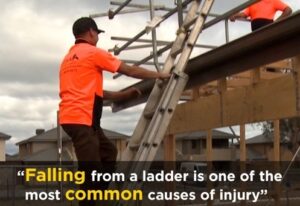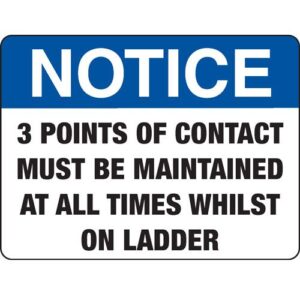 There are several times when you want to do a job quickly, but if that job happens to be at a height: PAUSE, and ask yourself: how much time is a serious injury going to cost me?
There are several times when you want to do a job quickly, but if that job happens to be at a height: PAUSE, and ask yourself: how much time is a serious injury going to cost me?
Falls from ladders are one of the most common causes of injury in Australia. Most falls from a ladder occur because the ladder is not in good condition or not set up and used correctly.
Falls from ladders can result in abrasions, dislocations and fractured limbs, spinal cord damage or severe brain injury and even death. In fact, on average 4 – 5 Australians (mainly men) die each year after falling from a ladder and nearly 1 in 10 falls from a ladder result in brain injury.
Follow our step-by-step guide to safe ladder use to prevent incidents and injury in your workplace or home.
Portable Ladders – When to use them
A portable ladder should only be used for simple access jobs or for short work durations. They should only be used if other alternatives, such as scaffolding or work platforms are not reasonably practicable.
A portable ladder should not be used for working at heights of six metres or more. For Heights above six metres, a ladder should only be used as access purposes.
Choose the right ladder for the job
- Ensure the ladder is the right type, height and size for the job.
- An extension ladder may be suitable for some tasks, but a platform ladder is safer.
- Check the weight capacity of the ladder. The combined weight of the person using the ladder and any items or tools should never exceed the working load limit of the ladder.
- The ladder should comply with Australian Standards (AS/NZS 1892.) and have a clearly displayed load rating of at least 120 kg.
- Metal ladders must be fitted with rubber feet or a similar non-slip material.
Before you start, check it’s safe
- Always inspect your ladder to ensure it’s in good condition before use. For example, there are no missing, worn, damaged or loose rungs, steps, top plates or feet; or missing, broken or worn ropes, braces or brackets.
- Only use a ladder if you are physically capable of doing so, taking into account your age and general health and wellbeing.
- Be aware of your work environment, e.g. surfaces, weather conditions, electricity lines or wiring, machinery and other objects, and have a plan in place to manage any risks.
- Do not use a ladder in wet or windy conditions unless using equipment or work practices that have been developed for such conditions.
- Do not work directly over other people. Barricade the area below if required.
Set the ladder up correctly
- Place the ladder on a flat and stable surface, well clear of powerlines and other obstructions.
- For soft, uneven or sloping surfaces, use a support under the ladder feet for levelling and stability, e.g. a ladder-levelling device such as additional, stabilising legs.
- Secure the ladder at the top or bottom (or both) to prevent slipping.
- Single or extension ladders should be angled at a ratio of 1:4. That is, position the base of the ladder 1 metre away from the supporting structure for every 4 metres of height.
- Engage all locks and braces on the ladder.
- A-frame ladders should only be used when locked in the fully-open position.
 Use the ladder safely
Use the ladder safely
- Always maintain three points of contact when climbing or descending the ladder. This means have two hands and one foot, or two feet and one hand on the ladder at all times.
- Wear fully enclosed, slip-resistant footwear.
- Face the ladder when climbing up the ladder.
- When climbing down the ladder, remain facing the ladder and step down the ladder, one rung at time, to the bottom rung before stepping off.
- Only take small items up or down a ladder – never large or heavy items such as building materials. Only carry items that allow you to maintain three points of contact.
- Do not climb or work past the second-last rung of a ladder and never straddle the top of an A-frame ladder
- Never lean or reach away from the ladder while using it.
REFERENCES
www.productsafety.gov.au/products/outdoor/workshop/ladders 2 Brain Injury Australia https://www.braininjuryaustralia.org.au/ladder-falls/ Safe Work NSW https://www.safework.nsw.gov.au/hazards-a-z/ladders
https://anchorsafe.com.au/wp-content/uploads/2021/02/FACT-SHEETS-Safe-use-of-Ladders.pdf
